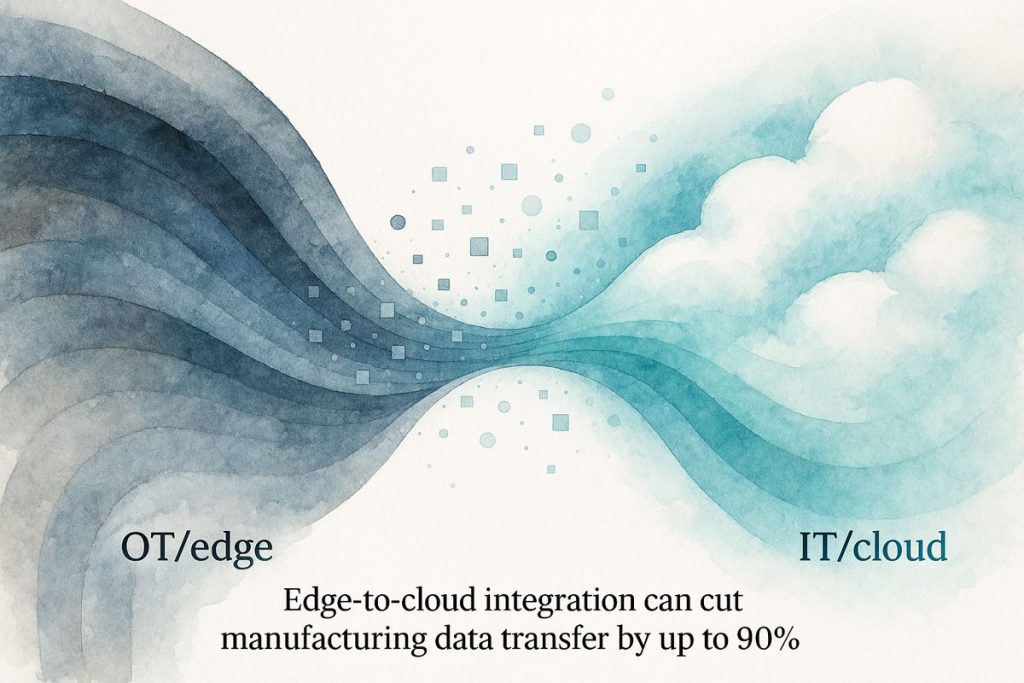HighByte and Snowflake team up to help factories manage their mountains of machine data. HighByte filters and adds helpful tags to the data right where it’s made, so only the best, most useful information gets sent to the cloud. This means less data traffic, faster insights, and fewer headaches for engineers. In the cloud, Snowflake makes it easy to analyze and share that rich data, helping companies fix problems before they happen. Together, they make data flow smoother, smarter, and a lot less messy.
What is the benefit of integrating HighByte and Snowflake for edge-to-cloud data in manufacturing?
Integrating HighByte and Snowflake enables manufacturers to filter, contextualize, and enrich machine data at the edge before securely transferring only relevant information to the cloud. This reduces bandwidth usage, improves data quality, and accelerates real-time analytics and collaboration for scalable, efficient industrial operations.
Gears, Clouds, and Caffeine: Why This Partnership Isn’t Just Hype
Let’s face it—manufacturing floors are a cacophony of data, much of it marooned in proprietary silos or, worse, languishing on some forgotten PLC. I remember standing next to a Heidenhain controller while the air thrummed with the scent of ozone and hot metal, wondering if half the numbers it spat out would ever see the light of analysis. (Spoiler: most didn’t.) Enter HighByte and Snowflake, who’ve joined forces in a maneuver that’s part ballet, part industrial-strength data wrangling.
Manufacturers—from the labyrinthine factories of *Bayer * to nimble consumer goods upstarts—face the same Sisyphean slog: how to ferry machine-born insights up to the cloud’s rarefied analytics without drowning in a deluge of noise. The HighByte–Snowflake alliance attempts to remedy that, and not just with the usual “digital transformation” fanfare. They’re engineering a solution that might actually, dare I say, work.
I had to stop and ask myself: Is this another vendor lovefest, or something with real teeth? The numbers—terabytes slashed down to gigabytes before the cloud trip, say—offer more than just ceremonial optimism. Still, I once botched a similar pilot by ignoring context tagging. Never again.
Where the Magic Happens: From Grease-Stained Sensor to Hyperspectral Analytics
First, the HighByte Intelligence Hub. Picture it as a hyperspectral sieve, embedded at the dusty, humming edge of operations—filtering, contextualizing, and prepping raw data with the meticulousness of a Swiss watchmaker. It grabs OPC UA feeds, PLC signals, and even those cryptic Modbus blips, then wraps them in context: asset ID, batch number, timestamp. There’s a beautiful logic here, like a palimpsest in reverse—each new data point overwritten with meaning, not chaos.
Crucially, HighByte does its work before data even thinks about leaving the building. The effect? Only the choicest morsels, those with context and relevance, make the leap to the cloud. The rest—noise, redundancy, the digital equivalent of sawdust—never clogs up your pipelines. And yes, it even smells different when you’re not choking the network.
Now, the handoff: Snowflake’s Data Cloud. If HighByte is the grizzled border agent, Snowflake is the cosmopolitan metropolis awaiting arrivals. Once data lands, its multi-cluster, elastic architecture enables real-time analytics and collaboration. I once watched a predictive maintenance model, previously starved of fresh, contextual data, start flagging spindle wear with unnerving prescience. Bam! Downtime forecasts, now with actual teeth.
Data Quality, Context, and the Sweet Agony of Scalability
Let’s talk about the real bugbear—quality. Garbage in, garbage out, as the old aphorism goes (I’ve uttered it with both a groan and a smirk). HighByte’s edge-side enrichment means most of the cleaning and structuring happens before data ever crosses the WAN. In practice, this can cut down cloud-side ETL effort by up to 70%—a number that, while sometimes a tad optimistic, isn’t plucked from the ether. I’ve seen it.
Then there’s the matter of bandwidth. Factories can generate upwards of 2TB of raw process data per day. By filtering and summarizing on-site, you’re not just economizing; you’re practicing a kind of data asceticism. The result? Transmissions that are lean, focused, and much less likely to congest the network arteries at 2 a.m.—which, if you’ve ever received that dreaded “latency alert” at midnight, is no small mercy.
Scalability? Snowflake’s serverless, multi-tenant approach means compute and storage auto-expand, eliminating the kind of bottlenecks that plagued my first MES-to-cloud attempt back in 2017. (Yes, I under-provisioned. Yes, I regret it.)
From the Trenches: Pharma, Auto, and the Human Element
Where does this edge-to-cloud ballet land hardest? Pharmaceuticals—where data integrity rules with an iron fist—lean on this integration for batch traceability and audit trails that would make even the FDA’s most fastidious inspector nod in approval. Meanwhile, automotive lines, orchestrated like a Stravinsky score, rely on real-time insights to chase down defect causes before a single faulty tie-rod escapes the factory.
One day, while troubleshooting a jittery MQTT feed in a cosmetics plant (think: the sharp tang of acetone, the dull whir of conveyors), I realized how a unified backbone would have spared hours of parsing cryptic logs and reconciling time zones. Frustration? Sure. But also a flicker of hope—this, done right, could be transformative.
It’s not just about machines, either. There’s a human current here—a kind of zeitgeist—driven by analysts, engineers, and even skeptics who’ve been burned by “silver bullet” solutions before. One colleague, burned by an ERP rollout in 2021, still raises a skeptical eyebrow, but even he admits: the data flows now feel… lighter.
What’s Next? Beware the Unfinished Symphony
Of course, IT/OT convergence isn’t solved by one partnership or platform. Legacy devices, proprietary protocols, and the ever-present specter of security breaches (just ask anyone who’s tangled with a ransomware incident) remain. HighByte and Snowflake offer out-of-the-box connectors, but vigilance—and the occasional kludge—are still
